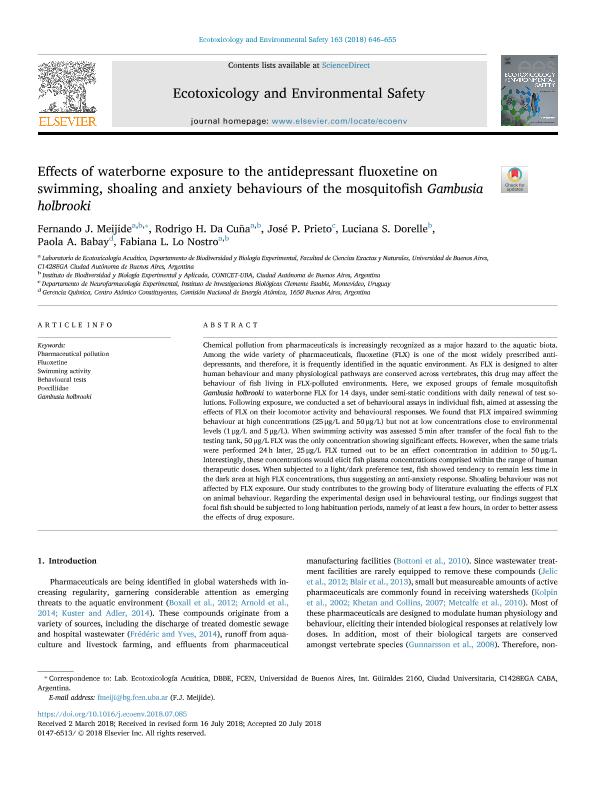Mostrar el registro sencillo del ítem
dc.contributor.author
Meijide, Fernando Javier

dc.contributor.author
Da Cuña, Rodrigo Hernán

dc.contributor.author
Prieto, José P.
dc.contributor.author
Dorelle, Luciana Soledad

dc.contributor.author
Babay, Paola Alejandra

dc.contributor.author
Lo Nostro, Fabiana Laura

dc.date.available
2020-01-30T15:40:53Z
dc.date.issued
2018-11
dc.identifier.citation
Meijide, Fernando Javier; Da Cuña, Rodrigo Hernán; Prieto, José P.; Dorelle, Luciana Soledad; Babay, Paola Alejandra; et al.; Effects of waterborne exposure to the antidepressant fluoxetine on swimming, shoaling and anxiety behaviours of the mosquitofish Gambusia holbrooki; Academic Press Inc Elsevier Science; Ecotoxicology and Environmental Safety; 163; 11-2018; 646-655
dc.identifier.issn
0147-6513
dc.identifier.uri
http://hdl.handle.net/11336/96217
dc.description.abstract
Chemical pollution from pharmaceuticals is increasingly recognized as a major hazard to the aquatic biota. Among the wide variety of pharmaceuticals, fluoxetine (FLX) is one of the most widely prescribed antidepressants, and therefore, it is frequently identified in the aquatic environment. As FLX is designed to alter human behaviour and many physiological pathways are conserved across vertebrates, this drug may affect the behaviour of fish living in FLX-polluted environments. Here, we exposed groups of female mosquitofish Gambusia holbrooki to waterborne FLX for 14 days, under semi-static conditions with daily renewal of test solutions. Following exposure, we conducted a set of behavioural assays in individual fish, aimed at assessing the effects of FLX on their locomotor activity and behavioural responses. We found that FLX impaired swimming behaviour at high concentrations (25 μg/L and 50 μg/L) but not at low concentrations close to environmental levels (1 μg/L and 5 μg/L). When swimming activity was assessed 5 min after transfer of the focal fish to the testing tank, 50 μg/L FLX was the only concentration showing significant effects. However, when the same trials were performed 24 h later, 25 μg/L FLX turned out to be an effect concentration in addition to 50 μg/L. Interestingly, these concentrations would elicit fish plasma concentrations comprised within the range of human therapeutic doses. When subjected to a light/dark preference test, fish showed tendency to remain less time in the dark area at high FLX concentrations, thus suggesting an anti-anxiety response. Shoaling behaviour was not affected by FLX exposure. Our study contributes to the growing body of literature evaluating the effects of FLX on animal behaviour. Regarding the experimental design used in behavioural testing, our findings suggest that focal fish should be subjected to long habituation periods, namely of at least a few hours, in order to better assess the effects of drug exposure.
dc.format
application/pdf
dc.language.iso
eng
dc.publisher
Academic Press Inc Elsevier Science

dc.rights
info:eu-repo/semantics/openAccess
dc.rights.uri
https://creativecommons.org/licenses/by-nc-nd/2.5/ar/
dc.subject
BEHAVIOURAL TESTS
dc.subject
FLUOXETINE
dc.subject
GAMBUSIA HOLBROOKI
dc.subject
PHARMACEUTICAL POLLUTION
dc.subject
POECILIIDAE
dc.subject
SWIMMING ACTIVITY
dc.subject.classification
Otras Ciencias Biológicas

dc.subject.classification
Ciencias Biológicas

dc.subject.classification
CIENCIAS NATURALES Y EXACTAS

dc.title
Effects of waterborne exposure to the antidepressant fluoxetine on swimming, shoaling and anxiety behaviours of the mosquitofish Gambusia holbrooki
dc.type
info:eu-repo/semantics/article
dc.type
info:ar-repo/semantics/artículo
dc.type
info:eu-repo/semantics/publishedVersion
dc.date.updated
2019-10-02T19:12:49Z
dc.journal.volume
163
dc.journal.pagination
646-655
dc.journal.pais
Estados Unidos

dc.description.fil
Fil: Meijide, Fernando Javier. Consejo Nacional de Investigaciones Científicas y Técnicas. Oficina de Coordinación Administrativa Ciudad Universitaria. Instituto de Biodiversidad y Biología Experimental y Aplicada. Universidad de Buenos Aires. Facultad de Ciencias Exactas y Naturales. Instituto de Biodiversidad y Biología Experimental y Aplicada; Argentina. Universidad de Buenos Aires. Facultad de Ciencias Exactas y Naturales. Departamento de Biodiversidad y Biología Experimental. Laboratorio de Ecotoxicología Acuática; Argentina
dc.description.fil
Fil: Da Cuña, Rodrigo Hernán. Consejo Nacional de Investigaciones Científicas y Técnicas. Oficina de Coordinación Administrativa Ciudad Universitaria. Instituto de Biodiversidad y Biología Experimental y Aplicada. Universidad de Buenos Aires. Facultad de Ciencias Exactas y Naturales. Instituto de Biodiversidad y Biología Experimental y Aplicada; Argentina. Universidad de Buenos Aires. Facultad de Ciencias Exactas y Naturales. Departamento de Biodiversidad y Biología Experimental. Laboratorio de Ecotoxicología Acuática; Argentina
dc.description.fil
Fil: Prieto, José P.. Instituto de Investigaciones Biológicas "Clemente Estable"; Uruguay
dc.description.fil
Fil: Dorelle, Luciana Soledad. Consejo Nacional de Investigaciones Científicas y Técnicas. Oficina de Coordinación Administrativa Ciudad Universitaria. Instituto de Biodiversidad y Biología Experimental y Aplicada. Universidad de Buenos Aires. Facultad de Ciencias Exactas y Naturales. Instituto de Biodiversidad y Biología Experimental y Aplicada; Argentina
dc.description.fil
Fil: Babay, Paola Alejandra. Comisión Nacional de Energía Atómica. Centro Atómico Constituyentes; Argentina
dc.description.fil
Fil: Lo Nostro, Fabiana Laura. Consejo Nacional de Investigaciones Científicas y Técnicas. Oficina de Coordinación Administrativa Ciudad Universitaria. Instituto de Biodiversidad y Biología Experimental y Aplicada. Universidad de Buenos Aires. Facultad de Ciencias Exactas y Naturales. Instituto de Biodiversidad y Biología Experimental y Aplicada; Argentina. Universidad de Buenos Aires. Facultad de Ciencias Exactas y Naturales. Departamento de Biodiversidad y Biología Experimental. Laboratorio de Ecotoxicología Acuática; Argentina
dc.journal.title
Ecotoxicology and Environmental Safety

dc.relation.alternativeid
info:eu-repo/semantics/altIdentifier/url/https://www.sciencedirect.com/science/article/pii/S0147651318306808
dc.relation.alternativeid
info:eu-repo/semantics/altIdentifier/doi/https://doi.org/10.1016/j.ecoenv.2018.07.085
Archivos asociados
